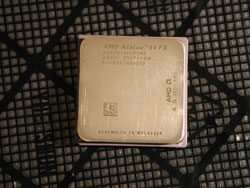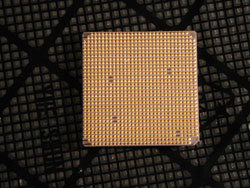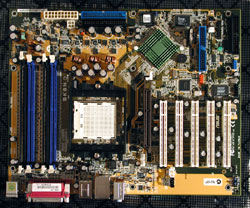|
|
|
|
|
AMD Athlon 64 FX-51 |
|
Join the community - in the OCAU Forums!
|
Introduction to AMD64, Asus SK8N
AMD is announcing two additional members of their AMD64 family today. Their Opteron CPUs have been in the market for about 6 months now and today the range is expanded to include two more products, Athlon 64 and Athlon 64 FX. The system we are looking at today is based on the Athlon 64 FX-51.

This is a 2.2GHz Socket940 CPU with a dual-channel memory controller onboard like the Opteron and 1MB of L2 cache at full core speed. AMD say this product is aimed at the gamer and "prosumer" (read: enthusiast) market. The Athlon 64 on the other hand has only a single-channel memory controller and is aimed at the desktop and mobile markets in Socket754. It is released at 2GHz with a Performance Rating of 3200+. The Athlon 64 can also use normal DDR memory, while the Athlon 64 FX and Opteron require registered DDR. This is usually bought as ECC registered DDR and carries the twin penalties of higher price and less availability of high-performance modules than normal unbuffered DDR. The Opteron is still very much a current product, targeted at the server and high-end workstation market. The Athlon 64 FX isn't simply an Opteron with a different name, though - it only has a single HyperTransport link while the Opteron has up to 3. HyperTransport is, briefly, the main bus between the CPU core and other components in the system - including other CPUs in a multi-CPU system. For more info on HyperTransport, see here.
 
I should make a quick note that this review was conducted in an extremely short timeframe with portions of it being prepared at different times. I won't go into the full cloak-and-dagger aspect of it, but suffice to say this is one product we had to pretty much sneak under the radar to even get a look at, and we're grateful to Plus Corporation for their assistance.
AMD64?
Of course, the main point about Opteron, Athlon 64 and Athlon 64 FX, collectively known as AMD64, is that they are a 64-bit x86 platform. What does that really mean for you right now? Not a lot, really. Moving from the current 32-bit CPUs to 64-bit is a natural progression for consumer computing, as we moved from 16-bit and 8-bit in the past. The end result from the user perspective will simply be higher performance, which can be used to provide greater realism in games, higher precision simulations, quicker manipulation of complex information like video and so on. AMD are fond of the term "cinematic computing", where your games and other PC experiences are as lifelike as a movie.
64-bit technology for the moment is a little ahead of its time and it'll take a while for the market to grow into it. Operating system support is appearing, with the recent release of a 64-bit version of Windows XP bringing it closer to the mainstream. There are 64-bit versions of Linux and probably other O/S's also. For the moment there's very little 64-bit native application software and none whatsoever that a gamer or enthusiast is likely to use. The main immediately-usable advantage then, is that you can address a lot more memory with a 64-bit address space. 32-bit CPUs are limited to about 4GB of memory. A 64-bit CPU can in theory address about 16PB (that's Petabytes, being a little over a million Gigabytes each). So if you're feeling cramped by that 4GB limit in your PC, consider a 64-bit solution. Obviously, corporations with large memory requirements are the people most interested by this aspect and probably the only people who would realistically use a 64-bit CPU in 64-bit mode at the moment.
However, one major advantage that the AMD64 platform has over Intel's competing Itanium offering is that it can natively run 32-bit applications, like you use every day, as well as the 64-bit software you may move to in the future. The gamer and enthusiast market, who are the target for this Athlon 64 FX product, are still running 32-bit software exclusively - so for now we will only examine the 32-bit performance of this chip.
Test Setup:
The motherboard in the Athlon 64 FX testbed is ASUS's SK8N, based on NVIDIA's nForce 3 pro150 chipset. Here's one out of the case for clarity:

This is a consumer-level Socket940 motherboard. Note there's only one "main" chip present on the board. This is the southbridge - remember that the AMD64 range have the northbridge functionality embedded into the CPU.
With only 4 DDR slots, if you wanted to go above the 4GB 32-bit limit for memory you'd have to find yourself some registered DDR DIMMS greater than 1GB in size. Good luck, and I hope you have your titanium credit-card handy.
|
|
Advertisement:
All original content copyright James Rolfe.
All rights reserved. No reproduction allowed without written permission.
Interested in advertising on OCAU? Contact us for info.
|

|


